September 2024 U.S. Container Imports Mark Third Consecutive Month of Elevated Volumes
In July, August and now September, U.S. container import volumes surpassed the 2.4 million twenty-foot equivalent units (TEU) threshold that has historically strained U.S. maritime logistics. In September 2024, U.S. container imports totaled 2,520,935 TEUs, just 1.4% shy of the year’s peak in July (2,556,180 TEUs) and up 1.7% over August (2,479,284 TEUs). Compared to September 2023, September 2024 volumes mark a significant 14.4% year-over-year rise and a 23.5% increase over pre-pandemic 2019. Notably, despite the higher import volumes this month, port transit delays have improved at the majority of top U.S. ports.
Read also: U.S. Container Imports Surge in June 2024 Amid Port Labor Stalls
Similarly, U.S. container imports from China have been at elevated levels over the last three months, with July (1,022,913 TEUs), August (975,129 TEUs) and now September (989,425 TEUs) posting the three highest monthly volumes on record. September volumes represent an increase of 1.5% from August 2024 and a 14.2% increase over the same period last year (866,762 TEUs). Chinese import volumes in September were down 3.3% from July’s all-time high.
The October update of logistics metrics from Descartes highlights the ongoing strength of container imports in 2024. However, looking ahead, U.S. importers face potential challenges associated with the recently resolved International Longshoremen’s Association (ILA) strike affecting South Atlantic and Gulf Coast ports, as well as the continued conflict in the Middle East, which are expected to continue to create global supply chain volatility through the remainder of 2024.
In this Article…
- U.S. container imports reached 2,520,935 TEUs in September 2024.
- Imports from China were 989,425 TEUs in September, up 1.5% from August and down 3.3% from July’s record high of 1,022,913 TEUs.
- September 2024 imports increased by 1.7% over August and by 14.4% compared to September 2023.
- For the fourth month in a row, the top West Coast ports increased their share of total U.S. imports, capturing more share than the top East and Gulf Coast ports.
- Despite growing imports, port transit delays improved at the majority of the top 10 U.S. ports in September.
- Reverberations from the recently resolved ILA labor strike at South Atlantic and Gulf Coast ports could continue to impact U.S. supply chains.
- Ongoing Houthi attacks and the Israel-Hamas conflict continue to force shipping route diversions from the Red Sea to the Cape of Good Hope.
- The Port of Baltimore regains its seat in the Top 10 U.S. ports, surpassing volumes at the Port of Philadelphia.
- Key points to monitor in 2024 to manage supply chain risks.
- Recommendations to help mitigate global shipping challenges.
U.S. container imports in September 2024 exceed 2.5M TEUs.
For the second time in 2024, U.S. container imports surpassed 2.5 million TEUs, reaching 2,520,935 TEUs in September (see Figure 1). This marks a 1.7% increase from August 2024 and a significant 14.4% rise compared to September of last year. Compared to pre-pandemic September 2019, September 2024 imports were up by an impressive 23.5%. September is the third consecutive month of import volumes exceeding the 2.4 million TEU mark that caused port congestion and delays during the pandemic years.
Figure 1: U.S. Container Import Volume Year-over-Year Comparison
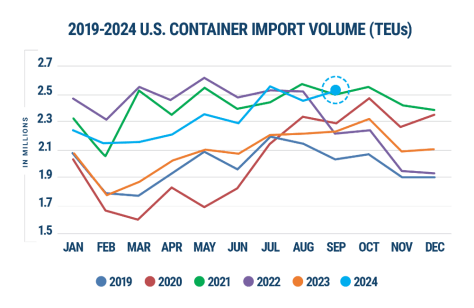
Similar to 2023, the volume increase in September 2024 over August breaks from the typical pattern of month-over-month declines. September 2024 recorded the highest volume for the month in the past six years, narrowly surpassing September 2021 by 1.2% (see Figure 2).
Figure 2: August to September U.S. Container Import Volume Comparison

In September 2024, container import volumes at the top 10 U.S. ports rose by 46,855 TEUs, a 2.2% increase compared to August 2024 (see Figure 3). The ports of Long Beach (up 50,401 TEUs), Charleston (up 13,357 TEUs), and Baltimore (up 6,144 TEUs) saw the largest gains. In contrast, the ports of New York/New Jersey (down 19,731 TEUs), Savannah (down 7,730 TEUs), and Tacoma (down 2,435 TEUs) experienced the most significant month-over-month declines.
Figure 3: August 2024 to September 2024 Comparison of Import Volumes at Top 10 U.S. Ports
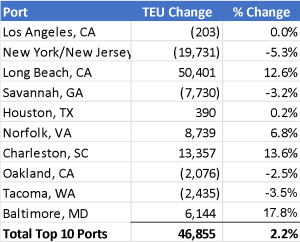
In September 2024, U.S. import volume from China reached 989,425 TEUs, a 1.5% increase (14,296 TEUs) from August and only 3.3% lower than the peak in July 2024 (1,022,913 TEUs) (see Figure 4). Year-over-year, September imports from China saw a strong 14.2% increase, reflecting the overall upward trend in 2024. The top two commodity categories (HS-2 codes) for August 2024 were consumer goods: HS-94 (Furniture, Bedding, etc.) and HS-95 (Toys, Games, and Sports Equipment, etc.). China accounted for 39.2% of total U.S. container imports in September, a slight decline of 0.1% from August and 1.4% below the February 2022 peak of 41.5%.
Figure 4: September 2023–September 2024 Comparison of U.S. Total and Chinese TEU Container Volume Relative to Chinese Import Record

In September 2024, U.S. container import volume from the top 10 countries of origin (CoO) fell by 41,680 TEUs, representing a 2.2% decline from August (see Figure 5). Among these countries, Vietnam (up 31,259 TEUs), India (up 19,410 TEUs), and Thailand (up 14,330 TEUs) experienced the largest volume increases. In contrast, Germany (down 11,479 TEUs), South Korea (down 8,291 TEUs), and Italy (down 7,485 TEUs) recorded the most significant volume decreases.
Figure 5: August 2024 to September 2024 Comparison of U.S. Import Volumes from Top 10 Countries of Origin
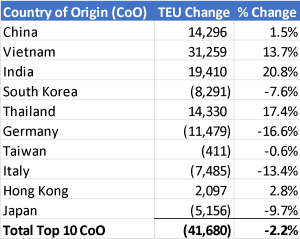
West Coast ports increase share of import volumes in September 2024.
For the fourth month in a row, the top five West Coast ports continued to hold a larger share of container import volumes compared to the top five East and Gulf Coast ports. While the data indicates marginal shifts in volume distribution among these ports, the share at West Coast ports rose from 45.0% in August to 45.7% in September, while the share at East and Gulf Coast ports declined from 40.5% in August to 39.6% in September. Overall, the dominance of the top 10 ports remained stable, experiencing a slight decrease in their share of total container import volumes from 85.5% in August to 85.3% in September (see Figure 6).
Figure 6: Volume Analysis for Top Ports, West Coast Ports and East and Gulf Coast Ports
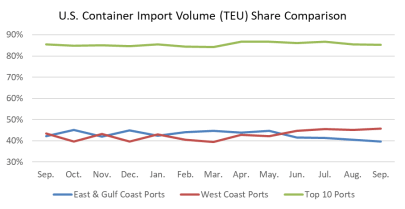
Port transit time delays improve across most West and East Coast ports.
For the top 10 U.S. ports, overall port transit time delays in September improved over August with seven of the top 10 experiencing decreasing delays. Of the top 10, the West Coast port of Tacoma saw the largest decrease. The port’s transit times declined by 2.8 days to 7.5 days compared to 10.3 days in August, likely due to the previously reported railway congestion beginning to ease. The Port of Seattle saw the largest increase in transit delays, growing by 1.7 days from 5.4 days in August to 7.1 days in September. The Seattle port experienced a ransomware attack in late August that caused disruptions throughout the greater part of September.
Figure 7: Monthly Average Transit Delays (in days) for the Top 10 Ports (Jul. 2024 – Sep. 2024)

Note: Descartes’ definition of port transit delay is the difference as measured in days between the Estimated Arrival Date, which is initially declared on the bill of lading, and the date when Descartes receives the CBP-processed bill of lading data.
Ongoing Red Sea attacks are diverting maritime traffic.
With shipping attacks and threats, the conflict in the Middle East continues to divert carriers away from the Suez Canal to Cape of Good Hope, elevating traffic at South African ports and raising carrier costs. Annual revenue at the Suez Canal has been reported to have dropped by almost a quarter of what was typical prior to the Red Sea crisis. Shipping concerns will likely increase if the Middle East is further destabilized.
Gulf Coast imports move higher in September 2024.
Gulf Coast imports grew for the second month in a row, increasing by 0.4% in September (226,458 TEUs) over August (225,473 TEUs) (see Figure 8). Port transit times at Gulf Coast ports remained relatively consistent in September, showing a moderate improvement over August.
Figure 8: October 2023 to September 2024 U.S. Gulf Coast Container Imports
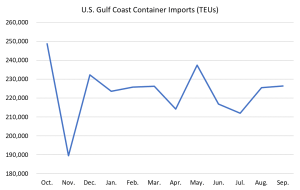
International Longshoremen’s Association (ILA) strike at South Atlantic and Gulf Coast ports reaches short-term resolution.
On October 1, nearly 50,000 members of the ILA went on strike across South Atlantic and Gulf Coast ports. As of October 4, however, a tentative agreement was reached to extend the collective bargaining period until January 2025; subsequently, ILA workers returned to work on October 4. Descartes will be monitoring October U.S. container import volumes for potential shifts in volume share between West Coast and East Coast ports, as well as for potential volume changes at Gulf Coast and South Atlantic ports, which could stem from the impact of the three-day strike.
Port of Baltimore regains its position amongst top 10 U.S. ports.
Following the reopening of the port in June, September import volumes at the Port of Baltimore have posted month-over-month gains, placing it among the top 10 U.S. ports again. September imports at the port reached 40,694 TEUs, a 17.8% gain over August (34,550 TEUs).
Managing supply chain risk: what to watch in 2024.
U.S. container import volume increased in September 2024, exceeding 2.5 million TEUs. The economy continues to exceed expectations, however, a third month of elevated container import volumes, the three-day ILA strike in October, and the ongoing conflict in the Middle East may create challenges for global supply chains. Here’s what Descartes will be watching for the remainder of 2024:
- Monthly TEU volumes between 2.4M and 2.6M. This level will continue to stress ports and inland logistics until infrastructure improvements are made. With three consecutive months of elevated volumes, ports may begin to show signs of struggle.
- ILA/USMX contract negotiation. While job action has been halted at East Coast and Gulf Coast ports, negotiations are ongoing, so it will be important to monitor these actions until a final contract is ratified.
- Port transit wait times. If they decrease, it’s an indication of improved global supply chain efficiencies or that the demand for goods and logistics services is declining. September 2024 transit delays decreased at both West Coast and East Coast ports, despite elevated monthly volumes.
- The economy. The U.S. is an import-driven economy, so economic health is an important indicator of container import volumes. Following the September Federal Open Market Committee (FOMC) meeting, the Federal Reserve borrowing rate was lowered 50 basis points to 5.1% while reported inflation was 2.5%. According to the Bureau of Labor Statistics August employment report, the unemployment rate remained mostly unchanged at 4.2% while employers added 142,000 jobs. The next FOMC meeting is scheduled for November 6-7.
- Middle East conflict. Houthi attacks are continuing to influence carriers to forego the Suez Canal, extending transit times around the Cape of Good Hope. The impact of diversions away from the conflict is still minimal on volumes or transit delays for East and Gulf Coast ports.
Consider recommendations to help minimize global shipping challenges.
September U.S. container imports volumes reflect the continued robust performance seen throughout 2024. Despite higher monthly import volumes, port transit delay times improved at the top 10 U.S. ports over the previous month. While the three-day ILA strike was suspended and work has resumed at affected ports, ILA/USMX negotiations remain ongoing until a final contract is reached, which is targeted for January 15, 2025. Strong month-over-month growth propelled the Port of Baltimore back into the top 10 U.S. ports, showcasing its remarkable recovery since reopening in June. The ongoing conflict in the Middle East is creating pressure on global supply chains that could cause disruptions throughout the remainder of 2024. Descartes will continue to highlight key Descartes Datamyne, U.S. government and industry data in the coming months to provide insight into global shipping.
Short-term:
- Monitor port volumes and delays to assess trade disruptions as imports remain between the 2.4M and 2.6M levels that have historically stressed U.S. maritime logistics infrastructure.
- Track the Middle East conflict as carriers divert shipping around Africa, impacting shipping capacity and timeliness.
- Evaluate the impact of inflation and the Russia/Ukraine and Israel/Hamas conflicts on logistics costs and capacity constraints. Ensure that key trading partners are not on sanctions lists.
Near-term:
- For companies that have cargo moving through the Suez Canal, evaluate the impact of extended rerouting caused by Middle East conflicts.
Long-term:
- Evaluate supplier and factory location density to mitigate reliance on over-taxed trade lanes and regions of the globe that have the potential for conflict. Density creates economy of scale but also risk, and subsequent logistics capacity crisis highlights the downside. Conflicts do not happen “overnight” so now is the time to address this potentially business disrupting issue.




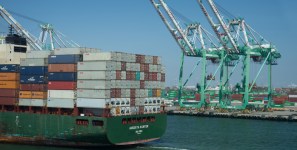
Leave a Reply